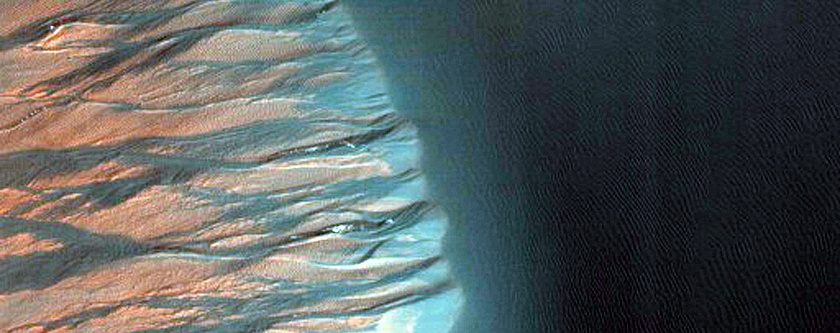‘Glowing’ Sand Dune Erosion on the Side of a Martian Crater
By Nancy Atkinson
While Mars is known as the Red Planet, a variety of colors can be found on the planet’s surface. Just like on Earth, the array of colors we can see in images from Mars comes from the diverse minerals on or just under the surface.
In the case of this picture, subsurface minerals show up in gullies that have eroded down the side of a a giant sand dune.
“Some of these gullies produce a variety of colors that are highlighted on the west-facing (illuminated) slopes, where the gullies appear to be glowing in the winter light,” explains the team from the incredible HiRISE camera, on board the Mars Reconnaissance Orbiter.

MRO has been orbiting Mars since 2006, and HiRISE has been snapping high-resolution images, showing the diversity of Martian surface. Kaiser Crater – and the field of giant dunes inside — has been a frequent target of study for HiRISE (see all the images here), so scientists have come to recognize the seasonal changes that take place at this ever-changing and shifting landscape. The HiRISE teams says that the giant sand dunes in Kaiser Crater experience gully erosion of the steep slip faces every year in late winter as the sun warms these slopes and seasonal carbon dioxide frost sublimates (meaning it changes from a solid to gas).
Kaiser Crater is located in Noachis Terra, an area on Mars that lies between the two giant impact basins on Mars: Argyre and Hellas. Noachis is so densely covered with impact craters that it is considered among the oldest landforms on Mars (the term “Noachian” comes from the Earth name Noah, referring to one of the earliest time periods.)

The post ‘Glowing’ Sand Dune Erosion on the Side of a Martian Crater appeared first on Universe Today.
October 12, 2021 at 08:19PM
via Universe Today read more...

Post a Comment